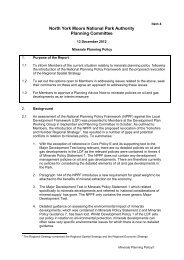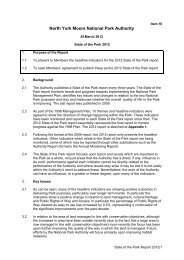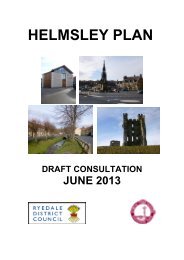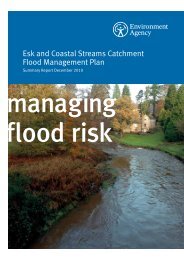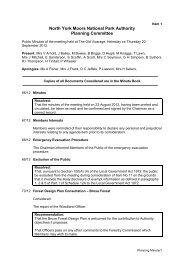Lowland wetlands - North York Moors National Park
Lowland wetlands - North York Moors National Park
Lowland wetlands - North York Moors National Park
Create successful ePaper yourself
Turn your PDF publications into a flip-book with our unique Google optimized e-Paper software.
<strong>North</strong> <strong>York</strong> <strong>Moors</strong> <strong>National</strong> <strong>Park</strong><br />
<strong>Lowland</strong> Wetland Habitat Action Plan<br />
2008– 2012<br />
<strong>North</strong> <strong>York</strong> <strong>Moors</strong> <strong>National</strong> <strong>Park</strong> Authority<br />
<strong>Lowland</strong> <strong>wetlands</strong><br />
Habitat action plan<br />
1 of 5
<strong>Lowland</strong> Wetlands<br />
<strong>North</strong> <strong>York</strong> <strong>Moors</strong> <strong>National</strong> <strong>Park</strong><br />
<strong>Lowland</strong> Wetland Habitat Action Plan<br />
2008–2012<br />
Objectives<br />
1. To maintain the quality and extent of lowland <strong>wetlands</strong> in favourable conservation<br />
condition, according to Natural England criteria.<br />
2. To improve the ecological quality of degraded lowland <strong>wetlands</strong>.<br />
Introduction<br />
Diverse lowland <strong>wetlands</strong> are among the most productive UK habitats and can<br />
support one of the most varied floral assemblages of all UK habitats. They support a<br />
vast and varied invertebrate biomass which in turn supports many breeding birds,<br />
notably waders and their chicks. Water voles, water shrews, otters and a variety of<br />
bats species are among the mammals that depend on good wetland habitat.<br />
The UK Biodiversity Action Plan priority habitats included in this plan are set out<br />
below. Some flush and swamp habitats may also be included, although those found<br />
at an elevation above enclosed farmland in the <strong>North</strong> <strong>York</strong> <strong>Moors</strong> are included in the<br />
Moorland Habitat Action Plan.<br />
• <strong>Lowland</strong> fen<br />
Fens are areas of wetland, often overlying peat, that are fed by groundwater<br />
as well as rainfall. Calcium-rich fen habitats are often very diverse botanically,<br />
and may contain rare plants such as globeflower and bird’s-eye primrose.<br />
They are often found in close association with flushes and springs. Fens in<br />
the <strong>National</strong> <strong>Park</strong> are exceptionally important for their invertebrates, including<br />
Eubria palustris, Vertgio geyeri, and a wide range of rare Diptera.<br />
• Reedbeds<br />
These are marshes dominated by the common reed Phragmites australis,<br />
where the water level remains above or at ground level all year. They contain<br />
few plant species, but contain a huge biomass of plant and invertebrate<br />
material, which in part explains why they are considered one of the most<br />
important UK habitats for birds.<br />
• Floodplain grazing marsh<br />
Grazing marshes are grasslands found on the floodplains of rivers, or in lowlying<br />
coastal zones that are known to flood at least once every 100 years. The<br />
best examples have high water levels, maintained by ditches rich in flora and<br />
fauna. Most have been improved for agricultural use by adding fertilisers;<br />
however, their wet nature makes them particularly valuable for breeding<br />
waders and wintering wildfowl.<br />
• Species-poor examples of purple moor grass and rush pasture<br />
<strong>Lowland</strong> purple moor grass Molinia caerulea and rush pastures are found on<br />
poorly drained soils in lowland areas with high rainfall. They are usually<br />
situated on undulating plateaux and hillsides, as well as in stream and valley<br />
mires.<br />
1 of 5
<strong>North</strong> <strong>York</strong> <strong>Moors</strong> <strong>National</strong> <strong>Park</strong><br />
<strong>Lowland</strong> Wetland Habitat Action Plan<br />
2008–2012<br />
<strong>National</strong> status<br />
Wetlands can be found in most parts of Britain, but intensive drainage for agriculture<br />
has greatly reduced their size and extent. Where they remain, it is only as isolated<br />
pockets of habitat which are often degraded as a result of intensive agriculture.<br />
The UK has about 56,000 ha of purple moor grass and rush pasture habitat, mostly<br />
concentrated in Scotland and Wales. There are about 5000ha of reedbeds remaining<br />
nationally, although of the 900 or so sites contributing to this total only 50 are greater<br />
than 20ha, and larger sites are mainly concentrated in the south-east of England.<br />
There is thought to be over 200,000ha of floodplain grazing marsh in England, but<br />
only 5000ha is deemed of good quality.<br />
Local status<br />
Wetlands have followed the national pattern of decline, largely because of<br />
intensification of farming. The small size and isolated nature of many of the patches<br />
of marsh and fen left within the <strong>National</strong> <strong>Park</strong> make these habitats particularly<br />
vulnerable to further degradation.<br />
Very little detail is available on the extent of wetland habitats within the <strong>Park</strong>. This is<br />
largely because the majority of sites form part of an intricate mosaic with other<br />
grassland, heathland and woodland habitats. Many potentially important sites have<br />
not been formally surveyed. Current knowledge suggests that there are only two sites<br />
remaining with extensive reedbeds, totalling 13ha. The <strong>Park</strong>’s most important<br />
lowland fens and purple moor grass and rush pastures are mostly found in and<br />
around forestry, where agricultural land management has been restricted. Forestry<br />
areas are particularly rich in calcareous fen with several important tufa-forming<br />
springs scattered within the Dalby Forest area.<br />
Many of the <strong>Park</strong>’s fen communities, such as M13 Schoenus nigricans mires, M22<br />
Juncus subnodulosus fen-meadows and Cirsio-Molinietum fen-meadows, are of<br />
national significance as they are at the edge of their geographical range.<br />
Legal status<br />
There are 18 ha of SSSI fen within the park, and many other designated sites contain<br />
some element of lowland wetland. Sites without designation have no specific<br />
protection from agricultural improvement.<br />
Links to other action plans<br />
Habitat Action Plans: Species Action Plans:<br />
Rivers and Streams*# Water vole*#<br />
Species rich grasslands Bats*#<br />
Farmlands Farmland birds*#<br />
Great crested newts*#<br />
Common toad*#<br />
Small pearl bordered fritillary*#<br />
* = Local Species Action Plan Orchids*#<br />
# = UK Species Action Plan(s) Geyers whorl snail#<br />
2 of 5
Threats<br />
<strong>North</strong> <strong>York</strong> <strong>Moors</strong> <strong>National</strong> <strong>Park</strong><br />
<strong>Lowland</strong> Wetland Habitat Action Plan<br />
2008–2012<br />
Odontomyia hydroleon#<br />
• Drainage to improve the value of land for agriculture has been the major<br />
cause of decline in lowland wetland habitats in the <strong>National</strong> <strong>Park</strong>.<br />
• Valley fens are particularly susceptible to pollution. Eutrophication from<br />
fertiliser run-off leads to increased plant growth and reduced species<br />
diversity. Trapped silt can dry out wet habitats, and toxins from agricultural<br />
chemicals can kill associated wildlife.<br />
• Many wetland sites are no longer being actively managed through grazing or<br />
cutting and many of these are showing an increase in coarse vegetation and<br />
encroachment by willow and alder scrub.<br />
• <strong>Lowland</strong> <strong>wetlands</strong> are not currently seen as a valuable agricultural resource<br />
and payments for maintaining them under agri-environment schemes often do<br />
not reflect their importance to wildlife or the cost of their management to the<br />
farmer.<br />
• There is a lack of up-to-date knowledge concerning the distribution and<br />
condition of lowland <strong>wetlands</strong> in the <strong>National</strong> <strong>Park</strong>, so valuable sites can be<br />
inadvertently lost.<br />
• <strong>Lowland</strong> wetland habitats cover a small total area in the <strong>National</strong> <strong>Park</strong> and<br />
have a highly fragmented distribution. Associated populations of plants and<br />
animals are vulnerable to local extinction because of their small size and the<br />
lack of connectivity.<br />
Requirements<br />
• Inappropriate drainage systems can be deliberately broken up to allow<br />
flushes and marshy grassland areas to redevelop.<br />
• Sensitive livestock grazing and/or cutting regimes are needed to keep<br />
invasive species and scrub at bay whilst breaking up, but not poaching, the<br />
soils and allowing the majority of plants to set seed in at least one year in<br />
three. Cattle and ponies may be particularly useful for this task.<br />
• Continuity of low-input management should be maintained, with the<br />
application of no inorganic fertiliser, no manure and no herbicides.<br />
• Invasive weeds such as creeping thistle and bracken may need to be topped,<br />
trampled, weed-wiped or spot-sprayed to prevent their spread.<br />
• Scrub should be managed to prevent it encroaching on wetland areas. Where<br />
wet woodland is an important component of the habitat, a diverse scrub edge<br />
zone should be encouraged.<br />
• Leave wide arable margins as buffer strips to adjacent <strong>wetlands</strong>.<br />
• Funding is needed for wetland restoration tasks to be carried out and to<br />
ensure the conservation management of a wetland network.<br />
• Further survey work is needed to identify wetland areas within the national<br />
park.<br />
Current Local Action<br />
• In agri-environment schemes, such as Countryside Stewardship,<br />
Environmental Stewardship or <strong>National</strong> <strong>Park</strong> schemes, land managers agree<br />
3 of 5
<strong>North</strong> <strong>York</strong> <strong>Moors</strong> <strong>National</strong> <strong>Park</strong><br />
<strong>Lowland</strong> Wetland Habitat Action Plan<br />
2008–2012<br />
to maintain <strong>wetlands</strong>. Money is also available in severe flooding areas for<br />
creating <strong>wetlands</strong>, usually through the blocking of land drains.<br />
• Biodiversity leaflets have been distributed to all farmers in the <strong>National</strong> <strong>Park</strong>,<br />
enabling them to identify <strong>wetlands</strong> on their land, describing how management<br />
can maintain or enhance the resource, and outlining ways money can be<br />
obtained for carrying out work through agri-environment schemes.<br />
Opportunities<br />
• There is potential for extending the wetland area within the park through the<br />
restoration of former wetland zones. This work could be used to help alleviate<br />
flooding and to allow for the movement and spread of wetland species.<br />
• Re-visit all species-rich lowland <strong>wetlands</strong> identified in either the 1987 Phase 1<br />
Habitat Survey, the 1991–1993 Phase 2 Survey or subsequently.<br />
What you can do to help<br />
Land managers:<br />
• Implement the list of habitat requirements above.<br />
• Liaise with the <strong>National</strong> <strong>Park</strong> over conservation land management.<br />
Public:<br />
• Assist the <strong>North</strong> <strong>York</strong> <strong>Moors</strong> <strong>National</strong> <strong>Park</strong> Volunteers with lowland wetland<br />
management. Phone the Volunteers Service on 01439 770657 for details.<br />
• Report flower-rich <strong>wetlands</strong> and rare plants to the <strong>National</strong> <strong>Park</strong> using the<br />
online recording form on the <strong>National</strong> <strong>Park</strong>’s website:<br />
www.moors.uk.net/recording<br />
• Leave all wild flowers for others to enjoy.<br />
4 of 5




